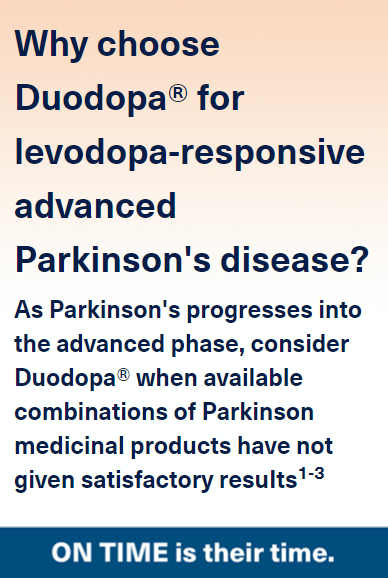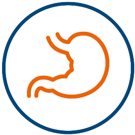Duodopa® may help provide symptom control in people with levodopa‑responsive advanced Parkinson's3
CDS=continuous dopaminergic stimulation; PD=Parkinson's disease.
1. Antonini A, et al. Curr Med Res Opin 2018;34(12):2063–73.
2. Dijk JM, et al. J Parkinsons Dis 2020;10:S65–73.
3. Duodopa® Summary of Product Characteristics, available on www.medicines.ie.
4. Boyd JT, et al. Clin Park Relat Disord 2020;2:25–34.
5. Nyholm D, Parkinsonism Relat Disord 2007;13(suppl):S13–17.
6. Slevin JT, et al. J Parkinsons Dis 2015;5:165–74.
Parkinson's progression leads to increased motor fluctuations, dyskinesias and a reduced quality of life1-3
- As the disease progresses and the therapeutic window narrows, people with PD typically require more frequent levodopa dosing4
- Delayed gastric emptying can lead to poor or delayed absorption of oral levodopa5
- At this stage, oral dopaminergic therapies no longer provide adequate symptom control3
Adapted from Olanow CW et al. 2006.
PD=Parkinson's disease.
1. Dijk JM, et al. J Parkinsons Dis 2020; 10:S65-73.
2. Odin P, et al. Parkinsonism Relat Disord 2015;21:1133-44.
3. Antonini A, et al. Curr Med Res Opin 2018;34:2063-73.
4. Nyholm D. Parkinsonism Relat Disord 2007;13:S13-7.
5. Doi H, et al. J Neural Sci 2012;319:86-8.
6. Olanow CW, et al. Nat Clin Pract Neurol 2006;2(7):382-92.
In advanced PD, continuous dopaminergic stimulation can be an alternative to pulsatile, non-continuous stimulation1,2
Adapted from Olanow CW et al. 2006.
- Continuous dopaminergic stimulation (CDS) can mimic normal physiological dopamine stimulation2
- This approach has the potential to improve advanced PD symptom control2,3
Consider CDS in people with advanced PD when oral dopaminergic therapies no longer provide
adequate symptom control1-3
1. Olanow CW, et al. Nat Clin Pract Neurol 2006;2(7):382-92.
2. Nyholm D. Parkinsonism Relat Disord 2007; 13:S13-7.
3. Boyd JT, et al. Clin Park Relat Disord 2020;2:25-34.
IE-DUOD-220031. Date of preparation: November 2022.















